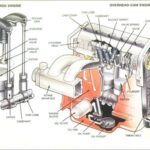Upgrading your car’s audio system opens up a world of richer, more immersive sound. While speakers are the voice of your system, and subwoofers bring the bass, amplifiers are the muscles that power it all, making them essential Car Sound System Parts. Let’s delve into why amplifiers are a must-have for any serious car audio enthusiast and touch upon other key components.
Just like your home stereo, your car comes with a basic sound system, including built-in speakers and an integrated amplifier. This factory-installed amplifier is sufficient for standard listening with the default speakers. However, if you’re looking to enhance your audio experience with high-quality component speakers or a powerful subwoofer, an aftermarket amplifier becomes a critical car sound system part.
Think of an amplifier as a megaphone for sound. Your car radio or media player sends a weak audio signal, like someone speaking softly. The amplifier, a key car sound system part, takes this faint signal and boosts it, providing the necessary power for your speakers to produce clear, loud, and dynamic sound. Without a dedicated amplifier, especially when adding power-hungry components like subwoofers, your upgraded speakers may not perform to their full potential, or worse, might not work at all.
When selecting an amplifier as part of your car sound system parts upgrade, you’ll encounter two important power ratings: RMS and peak power. RMS (Root Mean Square) power indicates the continuous power output of the amplifier. It’s the sustained power the amp can deliver consistently, and a more reliable indicator of its everyday performance. Peak power, on the other hand, represents the maximum burst of power the amplifier can produce during short, loud musical peaks. While a high peak power rating might sound impressive, RMS power is more crucial for judging the amplifier’s ability to maintain sound quality over extended listening sessions. Focus on RMS power when choosing your car sound system parts to ensure consistent and high-fidelity audio.
To effectively distribute the amplified sound to different speakers, especially in a system with subwoofers and component speakers, you’ll need to consider the channels an amplifier offers. Each speaker requires its own audio channel to operate. A two-channel amplifier can power a pair of speakers, but for a more complex setup with component speakers and a subwoofer, you’ll need a four-channel or even a five-channel amplifier. These multi-channel amplifiers, key car sound system parts, allow you to independently power different sets of speakers and optimize the audio output for each.
While amplifiers are central to powerful audio, the journey to car audio excellence involves other car sound system parts. Crossovers, for instance, are essential components that direct specific frequencies to the appropriate speakers. They ensure that your subwoofers handle the low bass notes, while your main speakers focus on mid and high frequencies, leading to a cleaner and more balanced soundstage. Exploring different types of speakers, subwoofers, and signal processors will further enhance your understanding of car sound system parts and how they work together.
In conclusion, when building a high-performance car audio system, understanding car sound system parts is paramount. Amplifiers stand out as crucial components for delivering the necessary power to bring your music to life. By choosing the right amplifier, considering RMS power, and understanding the role of other parts like crossovers, you can transform your car into a concert hall on wheels, enjoying superior sound quality on every drive.
